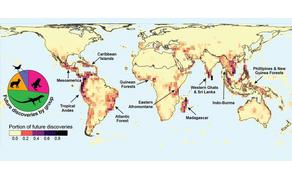
Maps are usually created to reflect landscapes, although a map that provides a forecast for the future can be a very important resource.
Following this logic that scientists have created a map that shows the places where most likely there are species of flora and fauna that humans have not yet discovered.
Considering climate change and other factors on Earth, it can be said that the biodiversity crisis has started. We are losing a variety of known species and perhaps those we are not aware of at an alarming rate. Knowledge is a force; therefore, a map created by science may be an important resource for documenting, classifying and saving animals.
"According to conservative estimates, only 13-18 percent of all species are found on Earth at this stage. Without conservation and commitment from countries, the species may disappear without us knowing anything about them," said a Yale University researcher.
Researchers say their model may not be accurate, but given a variety of factors - amphibians and reptiles - are the ones whose species are least found. Places where new species are most likely to be discovered are Brazil, Indonesia, Madagascar, and Colombia. The countries listed potentially represent a quarter of all future discoveries. The probability of the latest findings in tropical moist deciduous forests is much higher.




























